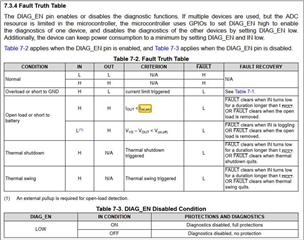Hi team,
My customer are using TPS1H200 HSD in our project, I have some question regarding the diagnostic.
From below table, after DIAG_EN pin is enabled,
Pin IN, we can control by our IOC;
Fault Pin: we can read out by our IOC;
For the OUT signal, does it mean we have to connect to one ADC of IOC, then it can support “FULL DAIGNOSTIC”?
(Full diagnostic means IOC can distinguish Normal/OPEN load/Short to Battery/Short to Ground state)



